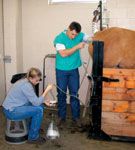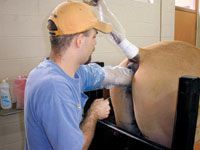Keys to successful equine embryo transfer
The right technique, embryo quality and donor-recipient synchrony are crucial.
Embryo transfer is accepted today as a valuable tool in equine practice to increase the number of progeny from genetically valuable mares and for obtaining foals from mares incapable of carrying a pregnancy to term.

Embryo transfer: Donor-recipient synchrony is considered the most important factor in achieving success with this procedure. (PHOTOS: COURTESY OF DR. ED KANE)
Most major breed associations (Quarter Horses, Arabians, Paint Horses, Morgans, American Saddlebreds) allow both embryo transfer and registration of multiple offspring produced by a given mare in a given year, including foals produced by assisted reproduction. A notable exception is the Jockey Club, which does not allow the registration of Thoroughbred foals produced by embryo transfer or other forms of assisted reproduction.

Timing is everything: Two of the most important considerations in embryo recovery are the timing of insemination and the fertility of the donor mare. Roughly 50 percent to 70 percent of embryo flushes should yield a healthy embryo.
In the 1990s, embryo transfer gained commercial value in South America, where it was developed as a means of producing offspring of polo ponies. Using nonsurgical embryo transfer methods reduced the need for more complicated surgical procedures. Also critical to the advancement of equine embryo transfer was the ability to transport equine embryos at 5oC for up to 24 hours without appreciable decrease in viability.
Unfortunately, commercial expansion of embryo transfer was hindered because mares were unusually resistant to the induction of superovulation and equine embryos were poorly tolerant of cryopreservation.
Even the most basic requirement for successful equine embryo transfer (i.e, adequate synchronization of the estrous cycles of donor and recipient mares) can be labor-intensive and difficult because of the significant variation in estrus length between animals.
"The majority of embryo transfer clients that I have want more than one foal from a particular mare, usually two or three," explains Pat McCue, DVM, PhD, the Iron Rose Ranch Professor of Equine Reproduction and director of the Equine Reproduction Laboratory at Colorado State University. "They'd like one foal from one stallion, the second pregnancy from a different stallion and a third foal from a third stallion," "An advantage of superovulation and embryo transfer is that by getting three or four ovulations, it increases our odds of getting at least one embryo out of that donor mare in a given cycle."
The second use of embryo transfer is for subfertile mares, ones that have had difficulty in maintaining pregnancies. "By transferring the embryo to a reproductively healthy recipient, hopefully that recipient will carry the foal successfully to term," McCue explains.
"The potential benefit of embryo transfer with a subfertile mare helps us get foals out of mares that we might not otherwise get foals from, but the aged subfertile mare may not be an ideal candidate for embryo transfer," explains Dirk Vanderwall, DVM, PhD, chief, Section of Reproduction, University of Pennsylvania's New Bolton Center. There is good evidence that inherent declining oocyte quality in the older mare — hence declining embryo quality in the aged mare — is likely a primary contributing factor to declining fertility in the mare that is in her late teens or 20 years and older.
"Twenty years ago, I think the feeling was that we could rescue embryos from a poor reproductive tract in an aged, subfertile mare, put the embryo into a young, fertile mare, and that was going to solve all of our problems," Vanderwall says.
Done experimentally in the 1980s at Cornell University, collecting embryos from aged, subfertile mares and putting them into young, fertile mares had a higher embryonic-loss rate than embryos collected from young, fertile mares transferred into other young, fertile mares.
A third purpose is for horse owners who want a foal from a mare to show, yet keep that mare open (i.e., not pregnant). "We do embryo transfer to give the pregnancy to a surrogate and allow the donor mare to remain open and continue to be shown," McCue says.
Embryo collection
"A component of embryo transfer is collecting embryos at one location and shipping them to a centralized embryo-recipient transfer facility," says Vanderwall. This allows the veterinarian working with the embryo donor to focus on breeding the embryo donor, flushing the embryo and not needing to worry about managing and synchronizing a recipient mare or several recipient mares. The transfer is left to the centralized transfer facilities, which are used by many veterinarians and their clients.
"That has really increased the use of embryo transfer, removing the onerous burden of having to maintain and monitor the embryo recipients from the person providing the breeding management and the embryo collection procedure for the donor," Vanderwall says.
Recovery of equine embryos is commonly done on Day 7 or 8 after ovulation, because the embryo does not enter the uterus from the oviduct until Day 5 or 6 — while the large size of a Day 9 or older embryo makes them more prone to damage during collection and transfer.
Due to the ease of manipulation of the anatomy of the equine cervix of the diestrus mare, the transfer of a Day 8 embryo (of 0.5-1mm diameter) is a less complicated procedure. A Day 8 embryo is visible to the eye. However, a dissecting microscope of 10x to 50x will be required to locate a Day 6 embryo and is critical in case the embryo is developmentally retarded or a smaller embryo from an asynchronous additional ovulation is present. Magnification will enable examination of the quality and developmental stage of the embryo (i.e., late morula, early blastocyst or expanded blastocyst).
Most critical to the success of embryo recovery is the timing of insemination and the intrinsic fertility of the donor mare and stallion. For most young, fertile mares with fresh semen from fertile stallions, 50 percent to 70 percent of flushes should yield an embryo. Success decreases significantly for older mares >14 years of age, with a history of subfertility, or when chilled, transported or frozen-thawed semen is used.
Another important factor for recovery success is the time at which the flush is performed relative to ovulation, because the equine embryo does not enter the uterus until Day 5 or 6 after ovulation. Therefore, flushing on Day 6 is often associated with a significantly lower embryo recovery rate because the earlier embryo has failed to exit the oviduct.
Superovulation is a way to increase the probability of success, the embryo yield and the number of pregnancies in recipient mares. But it's a difficult procedure for horses. Why?
"We don't have a set of medications for hormone therapy options," McCue says. Equine FSH (follicle stimulating hormone) and a recombinant equine FSH — both of which stimulate follicular development and get multiple ovulations in mares — are no longer commercially available.
"The second issue is, there are limitations in the horse as to how many follicles we can actually stimulate and how many ovulations we can get," McCue says. The anatomy of the equine ovary is limiting in that they have very large follicles, though mares ovulate through a very small section of the ovary, the ovulation fossa. There is a tough fibrous capsule that surrounds the outside of most of the ovary.
"We really can't get more than three or four large follicles to develop on each equine ovary, and they don't ovulate off the outside of the ovary, but through the ovulation fossa," McCue says. "Add all those things together and from a practical standpoint, even if we had the medications, our average ovulation rate in mares with superovulation is about three to four ovulations per cycle." That's not even close to the success rates in ruminants.
Transcervical transfer
Until recently, transfer of equine embryos at many facilities was performed surgically, either via ventral midline laparotomy under general anesthesia or through the flank using local infiltration anesthesia in the standing, sedated mare. Today, with significant improvements in the success of transcervical transfer, the surgical procedure is essentially obsolete because the newer method is easier, cheaper, quicker and better for the mare's welfare.
Certainly, nonsurgical transcervical procedure has made embryo transfer a more practical clinical procedure. But there are some important considerations for success. Minimizing contamination is very important, but can be potentially picked up from the mare's vulva or vagina. Minimal trauma to the cervical canal and endometrium is important too. Transfer success depends on several factors: embryo quality, proper transfer technique, donor-recipient synchronicity and recipient suitability.
Gross embryo quality, as assessed by a light microscope, affects embryo transfer success/pregnancy and the incidence of subsequent pregnancy loss. Fortunately, the majority (>90 percent) of harvested equine embryos are of good morphological quality.
The two major factors in technique that lead to failure are bacterial contamination of the progesterone-dominated uterus and/or hormonal disturbances initiated by excessive dilation or manipulation of the cervix. Therefore, some practitioners treat the mare with systemic antibiotics before and after the transfer to reduce the likelihood of bacterial contamination developing into a pregnancy-threatening endometritis. Flunixin meglumine is used immediately before a transfer, and progestagens are initiated for two to three weeks (or longer) post transfer to reduce the risk of pregnancy failure due to transfer-induced PGF2a release and luteolysis.
Donor-recipient synchrony is considered the most important factor for success. Large variability in estrus length between mares complicates the synchronization procedure. Good uterine and cervical tone at the time of transfer also is ideal for the establishment and maintenance of pregnancy.
Other factors important to establishing and maintaining a pregnancy in recipients after an embryo transfer include:
- good health and body condition
- between 3 and 12 years old
- exhibits normal cyclicity and shows no obvious signs of reproductive tract pathology
- cervix is undamaged and not unduly tortuous.
Size of the recipient mare compared to the embryo-donating mare is important too. Undergrowth or overgrowth of the fetus in utero, regardless of compensation of any compensatory post-natal development, may be maintained into maturity. Retarded growth within a smaller mare's uterus may present as physical and behavioral immaturity at birth. It can also delay a foal's time to stand and suckle.
Freezing embryos
In the past few years, Vanderwall says there has been more interest among veterinarians and their clients on the benefits of freezing embryos and using commercially available embryo vitrification kits. This method is more practical than traditional freezing procedures that involve the use of cryoprotectants like glycerol.
The primary benefit of the kits is that you can flush an embryo from a mare, whether you've got a recipient or not, freeze it and vitrify the embryo for transfer into a recipient mare at a later date. The main limiting factor is the need for collecting a Day 6 to very early Day 7 embryo.
For vitrification, the embryo needs to be less than about 250-300 microns in diameter: a morula-stage embryo to a very early blastocyst-stage embryo. The timing of the flush procedure becomes critical with the goal of collecting a very small-size embryo for vitrification.